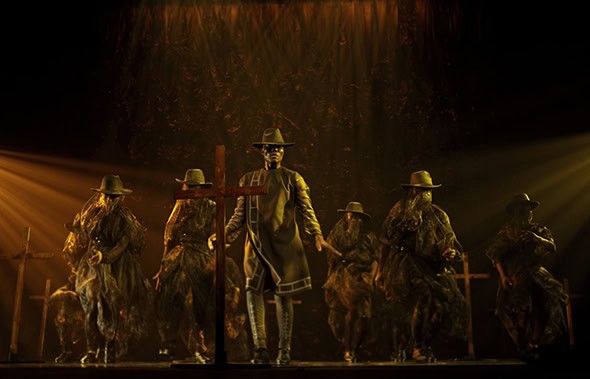Dance Umbrella 2019: Gregory Maqoma’s Cion: Requiem of Ravel’s Bolero at Barbican
Posted: November 13th, 2019 | Author: Nicholas Minns | Filed under: Festival, Performance | Tags: Black Coffee, Emma Gladstone, Gregory Maqoma, Jacques van der Watt, Jakes Mda, Mannie Manim, Maurice Ravel, Nhlanhla Mahlangu, Oliver Hauser, Sbussiso Shozi, Siphiwe Nkabinde, Thabang Mkhwanazi, Toloki, Xolisile Bongwana | Comments Off on Dance Umbrella 2019: Gregory Maqoma’s Cion: Requiem of Ravel’s Bolero at BarbicanDance Umbrella 2019: Gregory Maqoma’s Cion: A Requiem of Ravel’s Bolero at Barbican, October 18

In a pre-festival interview, the artistic director of Dance Umbrella, Emma Gladstone, talked of ‘difference’ as a factor in her programming. “To me difference is always part of the politics: looking at difference, understanding difference, not being afraid of difference. I think it’s something the art form as a whole can do very well.” Gladstone was referring to Gregory Maqoma’s Cion: A Requiem of Ravel’s Bolero that Dance Umbrella presented at Barbican as part of this year’s festival.
Maqoma’s work is, as its title suggests, a requiem, but for whom and under what auspices? It is based on two novels by South African novelist and playwright, Jakes Mda: Ways of Dying (1995) and its sequel, Cion (2007). Both novels follow the life and trials of Toloki, a professional mourner who earns his living traveling from funeral to funeral in the South African townships during the country’s fractious transition from apartheid to democracy, interceding between the horror of politically motivated brutality and the efforts of individuals and communities to come to terms with it. In Mda’s sequel, Toloki travels to the United States to research the history of slavery, so in taking on this narrative Maqoma assumes a vast history of violence, from racial injustice to internecine wars both in Africa and elsewhere. He writes that ‘Cion’s message of death and its dire consequences must be communicated through a lament in order to tackle a universe where the age-old phenomena of greed power and religion result in unnatural deaths.’
While the thrust of aggression is global, rituals of mourning belong very much to the local communities in which they occur. ‘Cion is as in Zion, the African church’, writes Maqoma. ‘It is set in a graveyard, a church where the body is religion and the voices are personal.’ Maqoma’s role is like that of Everyman, placing himself in a specifically African setting with a group of spirits or mourners (eight members of his own Vyuhani Dance Company) and a quartet of superb vocalists — beatboxer Siphiwe Nkabinde, Sbussiso Shozi, Xolisile Bongwana and Thabang Mkhwanazi — who sing compositions in Isicathamiya by composer Nhlanhla Mahlangu. The opening of Cion sees a lone, bent-over figure shuffling his way across a darkened stage of crosses giving expression to his grief in stifled, plaintive a capella sobs. It is a prologue that builds a powerful sense of mourning, and when the single snare drum beat of Maurice Ravel’s Bolero begins, the juxtaposition of cultures is ripe for exposition and resolution. When the lights come up, however, only a vestige of that opening mystery remains. The setting of a graveyard by Oliver Hauser, the costumes of Jacques van der Watt of Black Coffee and the exquisite lighting of Mannie Manim have the sophistication of a West End musical, while the figure of Mda’s Toloki ‘in his threadbare suite, cape and top hat’ is replaced by a stylishly dressed Maqoma whose movements in his five solos often exude the status of a pop idol; the itinerant mourner Toloki has become Michael Jackson.
Maqoma is familiar with, and in, the West — he trained at P.A.R.T.S. in Brussels and has toured widely outside South Africa to great acclaim (this is his third invitation to Dance Umbrella) — so he is well placed to combine his life experiences with his dancing and choreographic exploits. There is no doubting the sincerity of Cion’s conception and Maqoma’s desire to bring about catharsis, which he regards as ‘a universal grief that conquers the sadness continuing to permeate the living who are plagued by deaths that are not their own.’ By assimilating into this catharsis such a recognisably western piece of music as Ravel’s Bolero sung in Mahlangu’s arrangement by the a capella quartet, Maqoma suggests an imaginative conflation of the fate of his country with that of its colonial history. However, in Cion‘s translation of harrowing events from the South African townships to the Barbican stage there is a problem of theatrical signification; while the choral element maintains a powerful evocation that allows us to transcend difference, the choreographic and visual elements borrow too much from an overly familiar image of western contemporary dance — or even the classical tradition of soloist fronting a corps de ballet. Grief in artistic performance is always susceptible to a treatment that grants it exquisite form, but in the case of Cion there’s a risk the form inhibits the full realization of Maqoma’s catharsis.